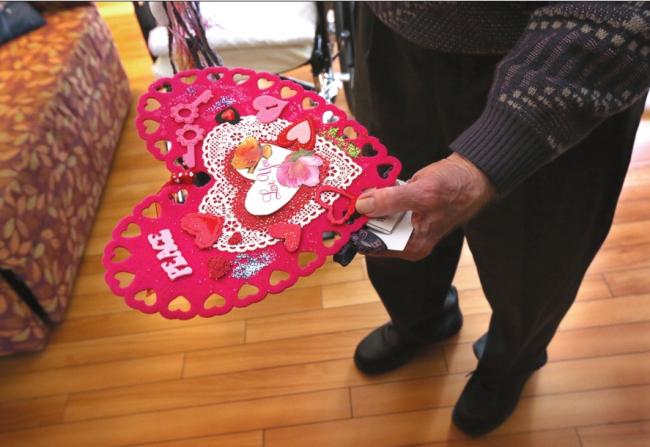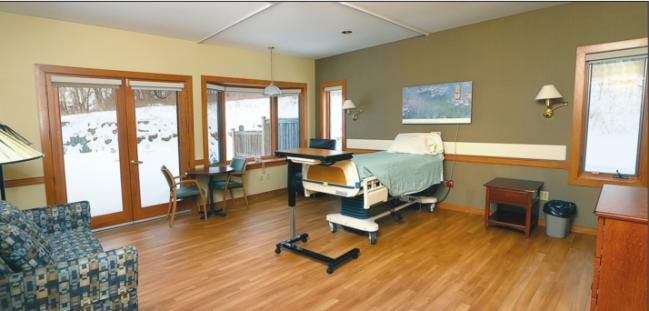
Inpatient hospice unit offers homelike setting
JANESVILLE
When Linda Lyman learned that her husband, Robert, was dying, she and her family had to make a painful decision about where he would spend his last days.
Robert had been a hospital patient who had received a stem-cell transplant after undergoing chemotherapy for non-Hodgkin’s lymphoma. But the transplant did not work, and the family’s hope for a cure disappeared.
“We were told that he probably had 10 days of strength left,” Linda recalls. “In the end, he had only five.”
Linda and her three adult daughters needed a place where they and Robert could be comfortable and close.
They found it at Agrace’s inpatient unit in Fitchburg, known as the Don & Marilyn Anderson HospiceCare Center.
Robert died in 2009. Today, Linda looks back with gratitude for the innovative environment, where her husband of almost 34 years received end-of-life care in a homelike setting.
 Linda of the town of Beloit supports a similar new inpatient unit under construction in Janesville. The $6.5 million Agrace Hospice & Palliative Care building at Wright Road and Sandhill Drive will be ready this summer.
Linda of the town of Beloit supports a similar new inpatient unit under construction in Janesville. The $6.5 million Agrace Hospice & Palliative Care building at Wright Road and Sandhill Drive will be ready this summer.
“I think it is a wonderful option for families in our community,” Linda said.
The 12-bed unit will help hospice patients like Robert with acute symptoms—including pain, anxiety and agitation—that cannot be managed at home. Some patients will die at the facility. Others will return home after brief stays.
For 35 years, the nonprofit Agrace has provided physical, emotional and spiritual support to patients and their families. The agency has long championed a philosophy of care that says people prefer to die in their homes or homelike settings surrounded by loved ones.
“The inpatient unit provided a beautiful homelike atmosphere, complete with medical necessities, to ease Robert’s discomfort in his final days,” Linda said. “Having medical experts trained in end-of-life issues right outside the door was so comforting for the family.”
The most important thing for Linda and her daughters was that Robert be comfortable.
“The girls and I were with him 24/7,” Linda said. “Our privacy was respected,
and we felt like we had an equal say in his excellent care. The staff
always came back to the family and wanted to make sure that they were
doing what we wanted.”
Mary
Barrows, facility operations manager, said Agrace is making
improvements in the new facility based on its experience at the
Fitchburg unit.
“We
are taking care to a new level in Janesville,” Barrows said. “We are
working hard to make sure we incorporate lots of things that will work
well with patients.”
 Among
them are carpeting instead of tile flooring to make the building
quieter; a family nook in patient rooms to give the patient privacy when
needed; and a covered entryway to the building to keep patients dry on
rainy days.
Among
them are carpeting instead of tile flooring to make the building
quieter; a family nook in patient rooms to give the patient privacy when
needed; and a covered entryway to the building to keep patients dry on
rainy days.
Agrace has
done much research during the years showing that patients want to die
at home or in a homelike setting. For people who need help managing
symptoms, however, the closest inpatient facility is now 35 miles away
in Fitchburg.
“We found there was an unmet need in south-central Wisconsin,” said Jayme Roth,
general manager of Agrace Rock County. “We are a nonprofit
organization. We are still reaching out to the community for support and
still need to raise about $2 million more for the campaign.”
The new inpatient unit will be the only one in Rock County.
Staff and volunteers will be trained in interacting and communicating with people facing death and their families.
Families at the unit will share a common bond.
 “Everyone
who walks through the doors is there because someone they care about is
facing an end-of-life illness,” Roth said. “That is different from a
hospital, where someone might be there to celebrate the birth of a
baby.”
“Everyone
who walks through the doors is there because someone they care about is
facing an end-of-life illness,” Roth said. “That is different from a
hospital, where someone might be there to celebrate the birth of a
baby.”
Roth calls the new inpatient unit much more than a building.
“We
realize the responsibility we have by serving these patients at this
most difficult time in their lives,” she said. “We are blessed to be
part of it, but it also carries a tremendous amount of responsibility to
provide their care as well as emotional, spiritual and grief support.”
Social worker Susan Henning makes sure patients and families have difficult conversations.
“I
initiate conversations about end of life,” she explained. “Have they
said their goodbyes? What are their final arrangements? Do they want
life-saving measures if they stop breathing?” She appreciates her
special role.
“I tell people thank you for the privilege to be with them in the last days of their lives,” Henning said.
One woman told Henning that the inpatient unit allowed her to be a wife again.
“Someone else was bathing my husband and giving him medication,” the woman said, “while I sat and held his hand.”
Registered nurse Carrie A. Cowan worked in intensive care for many years before coming to Agrace.
She saw how people struggled to stay alive.
“Our
first priority is the patient’s comfort and defining what that means,”
Cowan said. “We ask the patient what gives you joy and how can we help
you get it. We also talk about what may come physically for the patient.
If you have cancer, this is what you can expect, and this is how we
will manage it.”
The hospice team also looks out for the family.
“Our
goal is healthy survivorship,” she said. “We tell families we have one
chance to get this right. We want to make sure you have no regrets.”

INSIDE NEW BUILDING
Planners
of the new Agrace Hospice & Palliative Care building in Janesville
are creating a cozy and comforting atmosphere by:
- Choosing warm colors for the walls.
- Selecting homelike furniture.
- Hiding medical gases and equipment in cabinets so rooms look residential.
- Eliminating the use of ceramic tile and using carpeting in most public spaces to reduce noise.
- Creating a family nook in each room that can be partitioned with a curtain from the patient’s area for privacy.
- Providing overnight accommodations for family near the patient.
- Positioning
patient rooms across the hallway from each other so staff can get from
one patient to another quicker. In Fitchburg, rooms line only one side
of the corridor.
- Including a spa or a large tub where patients can be gently submerged in water.
“It
is very comforting and relaxing for the patient,” said Mary Barrows,
Agrace operations manager. “We also will have homecare patients who
cannot shower or take baths on their own use the spa.”
- Building a covered entryway.
“If
it is raining, patients will be out of the elements,” Barrows
explained. “It is such a good idea, we are looking at making the change
in Fitchburg.”
- Including private patios adjacent to rooms so patients’ beds or wheelchairs easily can be rolled outside.
“A patient can stay in bed and be outside with family,”Barrows said.“We have a lot of patients who take advantage of it.”
-
Providing a reflection space where families can have memorial services,
grief groups can meet and people can gather for community education and
outreach. Anyone can get help through grief groups and community
education.
- Building a palliative care-treatment room where
patients can meet with Agrace doctors and nurse practitioners to help
ease their symptoms and worries. A patient does not have to be eligible
for hospice care to receive palliative care. Palliative care can be
provided at any time during a serious or chronic illness.
- Having
a processional when a patient dies. The family, care staff and funeral
home people escort the patient out the front door when the patient dies.
“The
respectful way in which we do this helps families facilitate the grief
process,” Barrows said. “It’s also important to our staff. Many stop
what they are doing and go to where the processional is happening.”